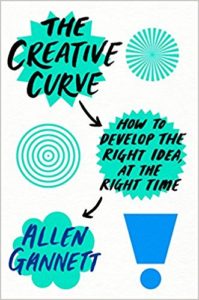By Rose O. Sherman, EdD, RN, NEA-BC, FAAN
 I often marvel at the creative ideas of others and wonder where the inspiration came from. In an outstanding new book, The Creative Curve, Allen Gannett debunks many ideas about creative genius. Most new innovation is actually an iteration of something that has already been done. Developing new ideas is a process which Gannett defines as the 4 laws of the creative curve. These include the following:
I often marvel at the creative ideas of others and wonder where the inspiration came from. In an outstanding new book, The Creative Curve, Allen Gannett debunks many ideas about creative genius. Most new innovation is actually an iteration of something that has already been done. Developing new ideas is a process which Gannett defines as the 4 laws of the creative curve. These include the following:
Law 1: Consumption
Creative ideas are the products of individuals who have consumed large amounts of information about their areas of interest. They have developed what Gannett calls cultural awareness or a real time ability to assess what is familiar, what is good and what is cliche. They can identify where ideas are on a creative curve and have outstanding pattern recognition and ability to see exemplars. This expertise, Gannett has found, is a product of spending 20% of their waking time consuming material in their field and real world experience. Insight is not magical – it is built on what you have read or been exposed to.
Law 2: Imitation
There is very little that is truly novel. Most new creations are built on remixes of things that have already been done. Gannett uses writing as an example, To be a great writer, you need to be a great reader first. That reading should be with intention of looking at what works.
Law 3: Creative Communities
In his work, Gannett has found that the most creative individuals work with others who are creative. They have had the benefit of master teachers, collaborators who challenge their ideas, individuals who inspire and motivate them and a prominent promoter who pushes their ideas forward. A study of Nobel Laureates versus other researchers in their same age group indicated that the Nobel prize winners had the benefit of a creative community which made their work possible.
Law 4: Iterations
Creative ideas are not one and done. They are the product of many intentional iterations. Creative innovations start with a conceptual idea that is edited into options worth testing, then curated then sent out for feedback. These iterations should be data driven to truly test the idea.
In addition to the laws, timing is critically important to creative innovation. People crave the familiar so the diffusion of ideas takes time and repetition. An interesting aspect of innovation is when something becomes too familiar or overused – people can just as quickly lose interest in it so understanding the creative curve is an art. If you are looking to improve your creativity and ability to innovate, these are ideas worth paying attention to. Gannett has taken the idea of creativity from the popular notion of light bulb moments to a well researched process.
© emergingrnleader.com 2018


 LinkedIn
LinkedIn Instagram
Instagram